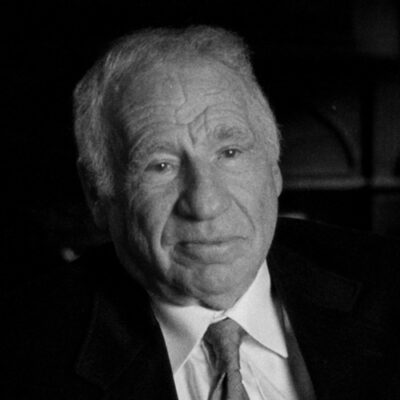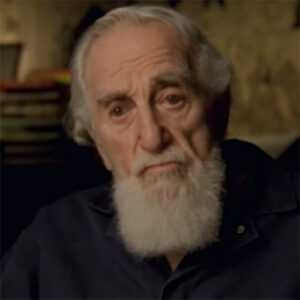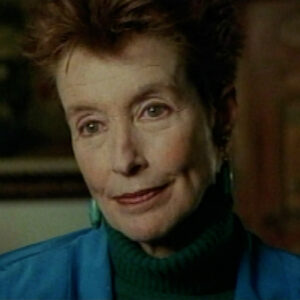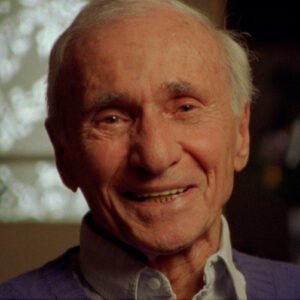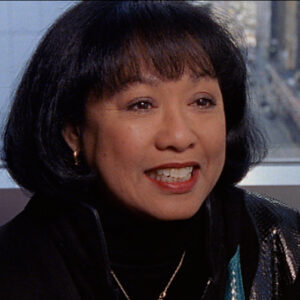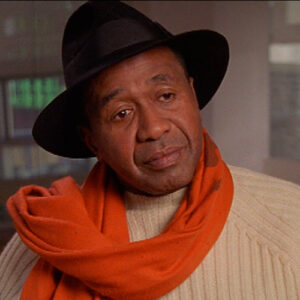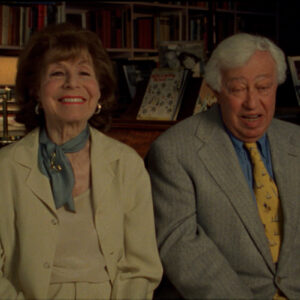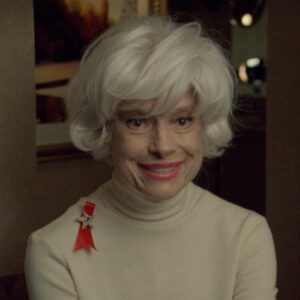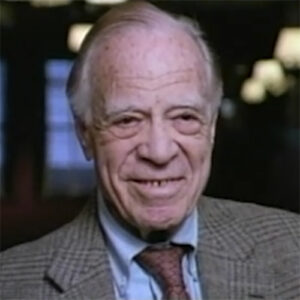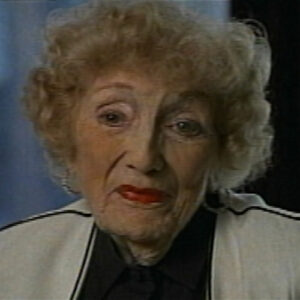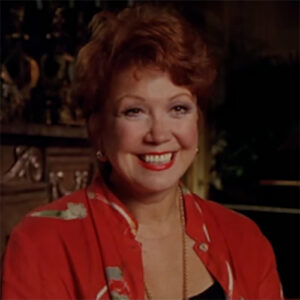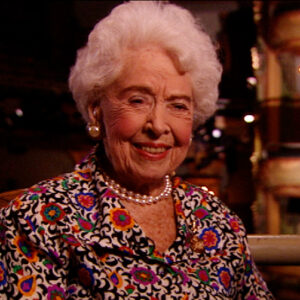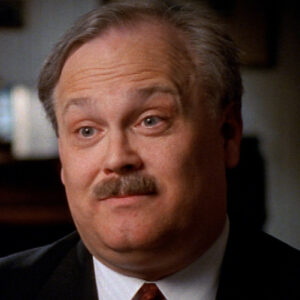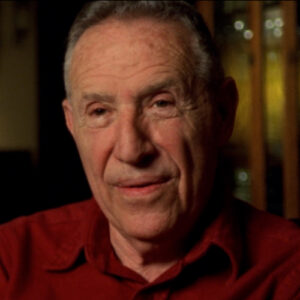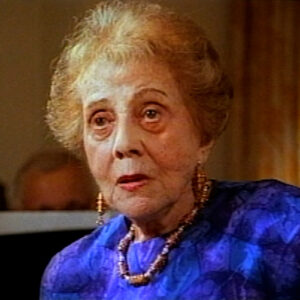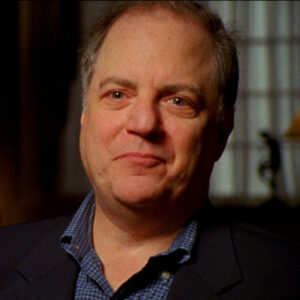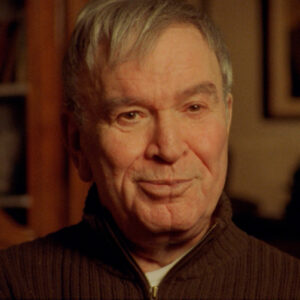Michael Kantor: So speak, if you would, just very generically about how the Broadway musical is a sort of fusion of high and low arts or the low entertainments meeting the high arts and how that all really combusts at the turn of the century or shortly thereafter and what have you. Just give us the broadest sweeping. It’s made of this, it’s made that. High, low, you know, because it is such a tough amalgam to describe. You’re always searching for it.
Robert Snyder: Broadway musical borrowed something from everything of the American theatrical world in the 19th century. It took from blackface, minstrelsy, vaudeville shows, light operas, street singers, wise guys and comedians, and it put them all together in a kind of American stew that could be created in New York.
Michael Kantor: Perfect. Thank you. The first episode takes us back to the Black Cruft very briefly. Tell us how in the 19th century, down near that area, downtown the Bowery, if you can mention that, there were all these entertainments and how these different things were assimilated into the Broadway musical as it moved uptown.
Robert Snyder: The theater world moved uptown throughout the 19th century in New York, going up the Bowery, going up the Broadway, through Union Square to Times Square. On that journey, it collected all sorts of influences from dime museums, vaudeville houses, melodramas, and it put them together when it reached Times Square
Michael Kantor: Place us downtown first. Say, in the downtown near where Niblo’s Garden Theater was, just blocks from the Bowery, there were all these, give us a sense of those lower entertainments, and then sort of weave in the other.
Robert Snyder: Down on the Bowery in the first third of the 19th century were a lot of the influences that would come together to form the musical theater. There were dime museums like Barnum’s Museum. There were minstrel shows. There were concert saloons that presented shows and prostitution for carousing men out on the town. They put all of that together to create the Broadway musical. Nibla’s Garden was down at Broadway and Prince Street and down there it could absorb all sorts of influences from German beer gardens. Minstrel shows, dime museums, melodramatic theaters, legitimate theaters, all of them could pour in and around the theater and rub off on each other down there. The key thing to understand about Lower Manhattan was that it was a neighborhood of immigrants, it was neighborhood of politicians, it was the neighborhood of businessmen, it was the neighborhoods of showmen, all them rubbing up against each other and all those influences swirling back and forth. Anybody who was in the theater business in 19th century New York how to figure out how to play to one of the most diverse audiences in the world. They had to figure how to have something for the middle class that wanted some respectability in their entertainment. They also had to figured out how play to men who were carousing out on the town. They had figure out to play immigrants who were far from home and maybe wanted a reminder of the old country. And the showmen who could figure out who to do that best were often the ones who succeeded.
Michael Kantor: And that’s exactly in a way what Broadway does. Broadway makes a more populist art out of a variety of entertainments. Take that and run with that.
Robert Snyder: The genius of Broadway was creating a theater that was both great theater and popular theater. With music that was great music that people could hum on their way to work. We think of Broadway when we think of the American musical because the American Musical flowered at the time that Broadway ran right up into Times Square and Times Square became a national entertainment district. From Times Square musicals went out and toured around the country. Reporters wrote columns that circulated around the nation and syndicated stories. And radios started to broadcast music, shows, comedy and dance and drama to the rest of the United States. We think of Broadway when we think of the American musical because the American Musical flowered in the days when Broadway and Times Square were at their heyday as a center of the America theatrical world. In the 20s and the 30s and 40s, Broadway was the center of American theatrical culture.
Michael Kantor: We sort of went over this, but how did the Broadway musical change in moving from lower Broadway to Herald Square, 34th Street?
Robert Snyder: As theaters moved from lower Broadway up to Herald Square and 34th Street, they always had to deal with the aura of vice and prostitution that shadowed the theater district. They never entirely shook that off, and in fact, it was that aura of naughtiness, vice, and big city ways that always clung to the theatrical world and made it frightening for some people and alluring to others.
Michael Kantor: Um I’m thinking, without mentioning Tony Pastor, describe how in moving up Broadway musical theater offerings became more respectable, more family-oriented, more populist, and really by, I mean, you can end with the idea that, you know, mentioning Harold Square, that’s where Cohen’s giving his regards to Broadway, it’s Harold Square epicentering, just around
Robert Snyder: Let me try to do two answers to that, because I think I can do it better in two than in one. As theaters moved up Broadway, from Union Square to Herald Square, a lot of the vaudeville entrepreneurs became ever and ever better at marketing to a broader audience of native-born and immigrant, middle class and working class men and women. As they broadened their audience, they broadend their appeal, and they made Vaudeville and the musicals that grew out of it into a really democratic American art form. Down on the Bowery, down on Union Square, Irish immigrants were still newcomers to the United States. When they appeared on the stage, they were immigrants singing about a new life in America. By the time George M. Cohan gets to Herald Square and later Times Square and he’s giving his regards to Broadway, he’s an American singing about an American life. It’s a triumph for Irish Americans. Throughout the 19th century, the theatrical district moved up the spine of Broadway through Union Square and finally to Herald Square. And that’s where George M. Cohen gave his regards to Broadway.
Michael Kantor: Here’s a really juicy question, which is, what was 42nd Street and Broadway like when it was Longacre Square? We need the wonderfully nasty flavor of the bordellos and the horses and so on. Tell us, you know, called, before it was Times Square, that area was.
Robert Snyder: Broadway on 42nd Street was first known as Long Acres Square, and it was a kind of nondescript neighborhood on the northern edge of the Tenderloin, with prostitution, stables, and ordinary buildings around it. When the subway arrived in 1904 and the New York Times moved in, it became a new kind of neighborhood. The Times expected that it was going to become a kind civic center, but they never gambled on the fact that New Yorkers with their sense of theater and public display and pleasure would make it an urban carnival zone. 42Nd Street and Broaddus on the northern edge of the Tenderloin, a neighborhood for vice and sex that got its name because a crooked policeman once was transferred there and he said, I’ve been getting by on Chuck’s steak all my life, now I’m going to get a bit of the tenderloin.
Michael Kantor: How did Times Square get its name? Any stories about the buildings going up there or the subway coming?
Robert Snyder: Times Square, like all the great squares in New York City in these years, got its name from a newspaper, Times Square. The New York Times. The New york Times expected that by moving up to that neighborhood, they would be in the heart of Midtown and they’d also be in the beginnings of a big civic center in Manhattan.
Michael Kantor: Um turn of the century theaters who were the patrons what was the evening the theater like in nineteen hundred i guess people came in carriages people came you know uh… Newfangled automobiles just describe right at the turn of the century before the subway then we’ll do one with the subway
Robert Snyder: There’s a great and very fertile variety of theaters in New York City around 1900. Vaudeville playing to a very broad audience, drama and melodrama playing perhaps a bit more to middle class people, cheap shows and dime theaters. It’s a very diverse and varied and dynamic scene with a lot of influences flowing in every direction.
Michael Kantor: But take us back first to the turn of the century. How did people get to the book?
Robert Snyder: In the turn of the century, before the subway came in, there were lots of ways to get to theaters. Richer people might go in carriages, poorer people could walk from the Bowery, and other folks could take the trolleys going across 14th Street or up and down Broadway. But the subway changed everything. It put the theaters of Times Square and Herald Square in the range of people who lived out in the boroughs, who wanted to come into Midtown and make it the entertainment center that it would become.
Michael Kantor: Great, let’s just get, you said, but the subway in case we need to come in separately. Just take it from the subway change there.
Robert Snyder: The subway changed everything about the theater district. It enabled people to get into it from all around New York City quickly and it turned midtown in Manhattan and Times Square into a big entertainment center for all of New York.
Michael Kantor: What was the most popular form of entertainment at the turn of the century?
Robert Snyder: Yeah, yeah.
Michael Kantor: Something for everyone.
Robert Snyder: At the turn of the century, vaudeville was the most popular form of theater in New York City in every sense of the term. It had the widest kind of audience and it also had the broadest array of acts. There was something for everyone in a vaudevilles show. The showmen who put the shows together tried to have something for the middle class, the working class, men, women, native born and immigrants, the very rough and the very respectable all at once.
Michael Kantor: How did Cohen get his start? I’m thinking, you know, in particular, a sort of Irish vaudeville.
Robert Snyder: George M. Cohen started out touring in his family’s Vaudeville act around the United States and he picked up song and dance from there and he carried those skills forward into the Broadway musical.
Michael Kantor: Tell us how Cohan, in particular, is a quintessential Irish performer. I mean, we look at Berlin, his father’s a cantor and whatever, but Cohan we want to paint as representative Irish. Yeah. Georgia.
Robert Snyder: George M. Cohen has the cocky, street-smart, tough-guy persona quick on his feet like a dancer or a prize fighter that was very popular among Irish performers in the 19th century. He carried that forward into musicals and he helped establish a kind of city kid persona that would be popular not only in Broadway, but in early Hollywood films.
Michael Kantor: Is there a way to typify, you know, the harrowing and heart, the sort of quintessential Irish, was it the knockabout comedy? What, what, how does Cohen typify Irish musical vaudeville, what have you? Am I stretching or?
Robert Snyder: No, no, let me think um In the middle of the 19th century, when Irish-Americans were newcomers to this country, they were all often looked down on as being un-American. Their loyalty was doubted in all sorts of ways. But by the time Cohan gets to be a star and he’s singing, Give My Regards to Broadway near a grand old flag, he’s Irish and he is defining what it means to be American. That’s a big victory for Irish in New York, and it also means a big deal about their in their American identity.
Michael Kantor: Just briefly, how does Vaudeville inform musical comedy? And, you know, how did it just feed in?
Robert Snyder: Vaudevillians put together the songs, dances, comedy, and rhythms of the city that would one day become a big part of the Broadway musical. Little pieces of the musical were formed in the Vaudeville stage and then carried forward into the musicals that flourished in the 20th century. Vaudevil spoke the language of big city New York and that carried over into Broadway musicals.
Michael Kantor: What was minstrelsy? Very briefly, white guys come up with a caricature of plantation life or something. Black minstrels adapt the forms that those have been created. And what was minstralsy?
Robert Snyder: Minstrelsy started out as white men putting on blackface makeup to put on songs, dance, comedy, and jokes. That was one of the most popular forms of theater in the 19th century. Minstrellsy was saturated with white supremacy, but it also had a vitality and energy and a vernacular voice that made it one of America’s first really popular forms of theater in every sense of the word.
Michael Kantor: But first the lights do it, but then black entertainment. Sure, sure. Pick it up as well.
Robert Snyder: Before the Civil War, most minstrels were white men in black face. After the Civil war, African Americans, with limited theatrical options, go into black face minstrelsy as well. A lot of them know that it means it’s going to limit what they can do on stage, but they recognize that it is an opportunity for them to perform and to present their art to a broader public.
Michael Kantor: What was blackface and why did people find it?
Robert Snyder: Blackface was a convention of putting on blackface makeup to mimic black people in the theater. White performers put on the mask of blackface, and they found it possible to be funny, unrestrained, and irreverent in ways that they wouldn’t be in their normal skin color. That’s because they attributed the traits of humor, childishness, and playfulness to African-Americans in a very racist sort of way. But they put the mask a blackface on, and it could become a different kind of person. One with more vitality, one with more reverence, one with more earthiness.
Michael Kantor: What about for black people, black performers like Burt Williams? What was Burt William’s comic genius?
Robert Snyder: But Williams’ comic genius was to create a kind of sympathy, a kind pathos around his plight as a black man on the stage. He could deal with sorrow in very lyrical ways. Williams had to put on black face makeup so his skin tone would conform to the stereotype. He knew that black face for him was a straight jacket. White performers found black face a liberating kind of mask. Black performers like Williams often thought it confined them.
Michael Kantor: It can find him, but he sort of stuck with it, didn’t he?
Robert Snyder: Yeah, but he was aware, he was acutely aware. Williams was acuely aware that if blackface makeup was his entry to the New York stage, it all was limited what he could do on stage. He wanted to present the broader outlines of black American people, but he knew that he was gonna be confined to the minstrel stereotype.
Michael Kantor: Why does, I mean, Speak to Blackface shows up in the 1860s, it’s in Hollywood movies and in American entertainment, it’s like the 50s, why is it so, why did it so capture American, why’s it so popular?
Robert Snyder: Blackface minstrelsy is one of the longest-lived conventions in the American theater, and it grows, I think, out of two things. One is a sense of white supremacy that does shape American culture in very harmful ways. The other, though, is the vitality, the vernacular voice, the irreverence of minstrelssy’s comedy, and that makes for very compelling theater that lots of people would enjoy for many years.
Michael Kantor: What do you think makes the Broadway musical so American? Why didn’t it start in Paris or London or something?
Robert Snyder: What makes the Broadway musical so American is that it’s open to all these influences from all sorts of different cultures based on your theatrical merit and nothing more than that. African American music, Jewish American music Irish American music light opera, minstrelsy, vaudeville, all these things come together in a kind of stew that’s essential to American culture and really flavors Broadway in ways that are very compelling.
Michael Kantor: What do the musicals that America’s loved over the years say about us as a country?
Robert Snyder: What the musicals say about America is that American art works at its best when it’s open to the widest variety of influences and when it mingles high and low in ways that can’t be easily predicted. That’s our genius.
Michael Kantor: What do you think is the myth of Broadway?
Robert Snyder: The myth of Broadway is that everybody becomes a star, but very few people can become stars. More people try to succeed on Broadway than ever succeed. There are plenty of people who fail and don’t get anywhere, but they still keep trying all the same.
Michael Kantor: Who is Walter Winchell and what did he have to do with Brian?
Robert Snyder: Walter Winchell was a gossip columnist who started out in Vaudeville, moved into newspaper writing and then got his own radio show that he mixed in with his newspaper column. He took the culture of Broadway and brought it to a nationwide audience. Broadway was its own little world in the heart of New York City. It had its own slang, its own hangouts, its street corners, its way of talking to itself. Winchell mastered that vocabulary as a vaudevillian and as a newspaper man. And then he exported it to the rest of the country in his columns and his radio show. The theater is game respectable by getting rid of two things, prostitutes and drinking. Both of them had been a big attraction in the 19th century. And by the end of the 19 century, the booze and the prostitues had been banished from theaters. That made them more open to middle class people and to families and to men and women out together on the town.
Michael Kantor: So Burt Williams, what do you think was his greatest gift?
Robert Snyder: Burt Williams had a rich, deep voice and he had a strong emotional range and he could express his sorrow and the pains that he felt in his signature song called Nobody. And with that song he could take the constraints of the blackface mask that he had to wear and get beyond it and bring the depths of a fully realized human character to the
Michael Kantor: How does media, you talked a little bit about Winchell, but just speak to the 20s and how media mythologizes Broadway, takes a new Broadway language and spreads it. If up till the 20’s everyone’s coming to Broadway, the 20 is going in.
Robert Snyder: Before the 20s, everybody’s going to Broadway on the subways, in cars, and visiting there to see the shows that can be found only in New York City. But in the 20’s, with the birth of radio and the growth of tabloid newspapers, suddenly the Broadway feel and the Broadway style start to be exported to the entire country. Radio takes the sounds of New York city and they send them to the rest of America. And columnists like Walter Winchell take the gossip and the feel and the slang of Broadway. And they send it to the rest of the country. Up until the 20s, Broadway’s a New York City story. After the 20’s, it’s an American story.
Michael Kantor: Who is Eddie Cantor, and what does he tell us about the Broadway experience?
Robert Snyder: Eddie Cantor is a classic comedian, wise guy, who started out as an immigrant Jewish kid on the Lower East Side, worked his way through a thousand tough joints, and finally made it big in the world of vaudeville and then Broadway in his prime.
Michael Kantor: What was he like on stage, what was his special talent?
Robert Snyder: Cantor had an energy and a humor that he knew came from growing up on the sides of New York. Cantor has an energy in a humor that he new came from growing up on the sidewalks of New york. He absorbed the energy of the city, then he gave it back to his audience when he appeared on stage.
Michael Kantor: So I think, I mean, speak to, I guess David Nessa wrote about this sort of, this abandon, this, you know, we look at it now and it’s too much energy, but it spoke to the street urchin-
Robert Snyder: Eddie Cantor, like a lot of other performers of his generation, grew up doing songs and dances on street corners. We had to compete with the noise of passing trolley cars and horse-drawn wagons to attract a crowd. He kept that energy, brought it to the vaudeville stage, and then he brought it the Broadway theater. And he always maintained that high-powered presence on stage. Today we might look at it on a movie film and feel that it’s a bit too much. But he was used to competing for his audience’s attention with all sorts of distractions. And he brought an energy to that job that he never let go of.
Michael Kantor: Go to Times Square in the jazz age and Prohibition. Speak to the Broadway community, the Broadway hangouts like Sardi’s. But there’s some. I just want a sort of sense of the Broadway community.
Robert Snyder: Mm-hmm, mm-hmm. Broadway was its own little world. It had not only its theaters, but hotels that performers stayed in, cafes where they hung out, corners where they looked for work. And together, it created its own little world in the heart of New York City. It had its own language. It had it’s own way of behaving. And the performers and show people who lived there and worked there grew accustomed to its culture. Vaudeville and Broadway were very competitive, and performers knew that there was a thin line between being a star and being a has-been. They used to congregate in front of the Palace Theater, looking for work, looking for booking agents that might want to sign them up, trying to impress each other. George Burns used to put a little makeup on the edge of his collar so that people would always think he was working, even if he wasn’t.
Michael Kantor: Bro, let’s speak web, bro, let us.
Robert Snyder: Broadway thrived on the energy of New York City streets. But by the 70s, when people were fearful of crime, when they’d lost the habit of going out and instead were more comfortable staying home and watching television, when the theaters were getting old, Broadway and Times Square started to lose some of the luster that they had had for people, started to become less of an attraction for them.
Michael Kantor: Great, what do you think of the new 42nd Street? And you know, say places since the mid 90s, there have been huge changes.
Robert Snyder: The old Broadway was a heartbeat for New York City and then for the United States of America. The new Broadway is a piece of the global entertainment and information industry. It doesn’t have an organic connection to New York city the way the old Broadway did. Broadway and 42nd Street is a crossroads. A crossroads is where people meet. And the energy of New York comes from different people from all over the world meeting on the streets of the city. That’s what gave Broadway and Times Square their energy. Broadway and 42nd Street are in the heart of New York City, but they’re also the heartbeat of New York City. They’re the meeting place where people from all over the city and all over world cross paths with each other. And that’s where the energy of New York City comes from. And that is where the Energy of Broadway theater has come from. It’s come from the ground up, from the millions of people who come to New York and contribute something to the city and its sounds. And as long as Broadway reflects that, it’s dynamic and it’s part of the city.
Michael Kantor: So back to the new 42nd Street. Speak to, you know, what’s happened is no longer a theater’s run by brothers, pairs of brothers, or a couple of dishonest businessmen. But they’re sort of conglomerates now, right?
Robert Snyder: Broadway theaters used to be run by people who grew up on the streets in New York and worked their way up through the show business world. Now they’re run by conglomerates on street corners where they’re across from financial information firms and corporate conglomers that sell electronic gadgets. They’re part of a world economy of information and money and finance. Broadway’s no longer part of New York City the way it was at the turn of the century.
Michael Kantor: Set up this idea of Broadway and 42nd Street since the creation of Times Square as some of the most valuable real estate in the world and that people, whether they’re Schubert’s and the syndicate or other, have always targeted that spot as, you know, with the exception of the 70s and so on. It’s just a prime, it’s like a prime… You know, think of a more famous spot, I don’t know. But just that since the inception of Times square, it’s been a focal point for the city.
Robert Snyder: Throughout the 20th century, people recognized that Times Square was central to the world of American theater, and what mattered in American theater was going to be fought out for better or for worse on Times Square. Was the theater going to reflect the energy of the city and the United States of America? Was it going to one piece of a global entertainment conglomerate? That battle’s been fought out in Times Square for more than 100 years now. It’s hard, if not impossible, to pick a first Broadway musical. Because there are so many influences coming into Broadway from all corners of the American theater world. We just know that at a certain point in time, we see this integration of music, song, plot, story, book that creates the Broadway musical that we know today. You know, black people, white people, everybody thought in stereotypes in the late 19th and early 20th century. Black people, White people, native born immigrants, they all use stereotypes to categorize each other. They had to make sense of a world of all sorts of different kinds of people. And they boiled those people down into one or two characteristics, good and bad.

